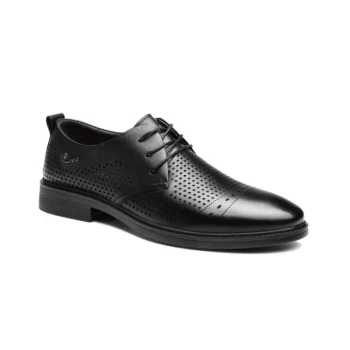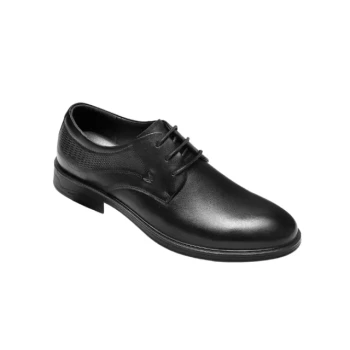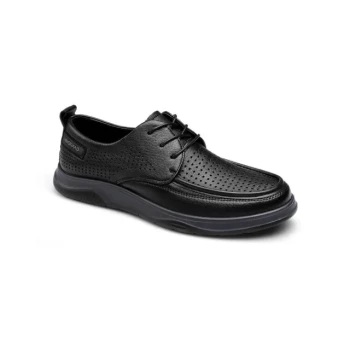The primary advantage of Goodyear welted shoes is their exceptional longevity, which is made possible because they can be repeatedly resoled. This construction method allows you to replace the worn-out sole without damaging the valuable leather upper, effectively giving the shoe multiple lives.
The choice between a Goodyear welt and a cemented sole is not just about construction; it's a decision between a long-term, repairable investment and a more affordable, flexible, and often disposable option.
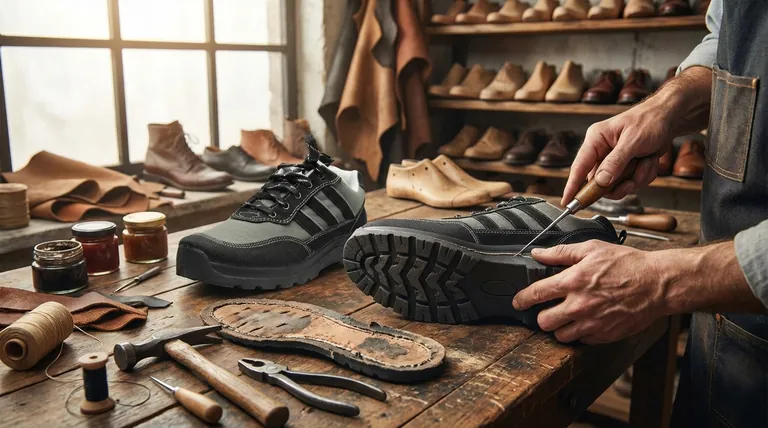
The Mechanics of Construction: Welt vs. Glue
To understand the core difference in longevity, you must first understand how each shoe is assembled. The construction method directly dictates the shoe's durability and repairability.
The Goodyear Welt Method
A Goodyear welt uses a strip of leather (the welt) that runs along the perimeter of the shoe. This welt is first stitched to the upper and the insole.
The outsole is then stitched directly to the welt. This creates a durable and water-resistant buffer between the upper and the outsole.
The Cemented Method
Cemented construction is a simpler, more common process. The shoe's upper is shaped and then attached directly to the outsole using a strong adhesive.
There is no stitching or welt involved. This method is faster and less expensive, allowing for lighter and more flexible footwear.
Why Repairability is the Decisive Advantage
The ability to resole a shoe is the single most important factor in its long-term value. This is where the Goodyear welt construction truly excels.
Preserving the Leather Upper
In a high-quality shoe, the leather upper is the most valuable component. With proper care, it can last for decades, developing a unique character and patina over time.
Resoling allows you to preserve this valuable upper while replacing the part of the shoe that naturally wears down with use—the sole.
A Simple and Clean Repair
When a Goodyear welted shoe needs a new sole, a cobbler simply cuts the stitches holding the outsole to the welt. A new sole can then be stitched on without ever interfering with the upper.
With a cemented shoe, the glued sole must be pried off. This process often damages the upper material, making a clean repair difficult or impossible.
Long-Term Value Over Initial Cost
While Goodyear welted shoes have a higher initial cost, their ability to be resoled multiple times means they can last for 10, 15, or even 20 years. This makes them a superior long-term investment.
Cemented shoes are less expensive upfront but are typically discarded once the sole wears out, leading to more frequent replacement costs.
Understanding the Trade-offs
Neither construction method is universally superior. The right choice depends on balancing durability with other important factors.
Flexibility and Comfort
Cemented shoes are often more flexible and comfortable straight out of the box due to the lack of rigid internal components.
Goodyear welted shoes can feel stiffer at first and usually require a break-in period for the leather and cork footbed to mold to your foot.
Style and Design Freedom
The direct gluing process of cemented construction allows for sleeker profiles, thinner soles, and more varied toe shapes. This makes it ideal for many modern and delicate shoe designs.
The Goodyear welt process results in a more substantial and often chunkier profile, which is characteristic of classic dress shoes and sturdy boots.
Cost and Accessibility
Cemented construction is less labor-intensive and therefore significantly more affordable. This makes it the standard for the vast majority of shoes on the market.
Goodyear welting is a hallmark of premium, craft-focused shoemaking, which is reflected in its higher price point.
Making the Right Choice for Your Needs
Your decision should be guided by your specific priorities for the footwear.
- If your primary focus is long-term value and durability: A Goodyear welt is the unequivocally better choice, as it is an investment built to last and be repaired.
- If your primary focus is initial affordability and out-of-the-box comfort: Cemented shoes offer a practical and cost-effective solution for everyday wear.
- If your primary focus is a sleek, lightweight, or modern design: Cemented construction provides the flexibility needed to achieve styles that are not possible with a welt.
Understanding how a shoe is made empowers you to choose the right tool for the job.
Summary Table:
| Feature | Goodyear Welted | Cemented |
|---|---|---|
| Primary Advantage | Can be resoled multiple times | Lower initial cost |
| Longevity | 10-20+ years with proper care | Typically disposable after sole wear |
| Construction | Welt stitched to upper and outsole | Upper glued directly to outsole |
| Repairability | High - sole replaced without damaging upper | Low - repair often damages the upper |
| Initial Cost | Higher | Lower |
| Best For | Long-term value, durability, investment | Affordability, specific modern designs |
Ready to Invest in Durable, Repairable Footwear?
As a large-scale manufacturer, 3515 produces a comprehensive range of high-quality footwear for distributors, brand owners, and bulk clients. Our production capabilities encompass all types of shoes and boots, including durable Goodyear welted constructions built to last.
Partner with us to provide your customers with superior value and longevity. Let's discuss how we can meet your specific needs for reliable, repairable footwear.
Contact our team today for a consultation!
Visual Guide
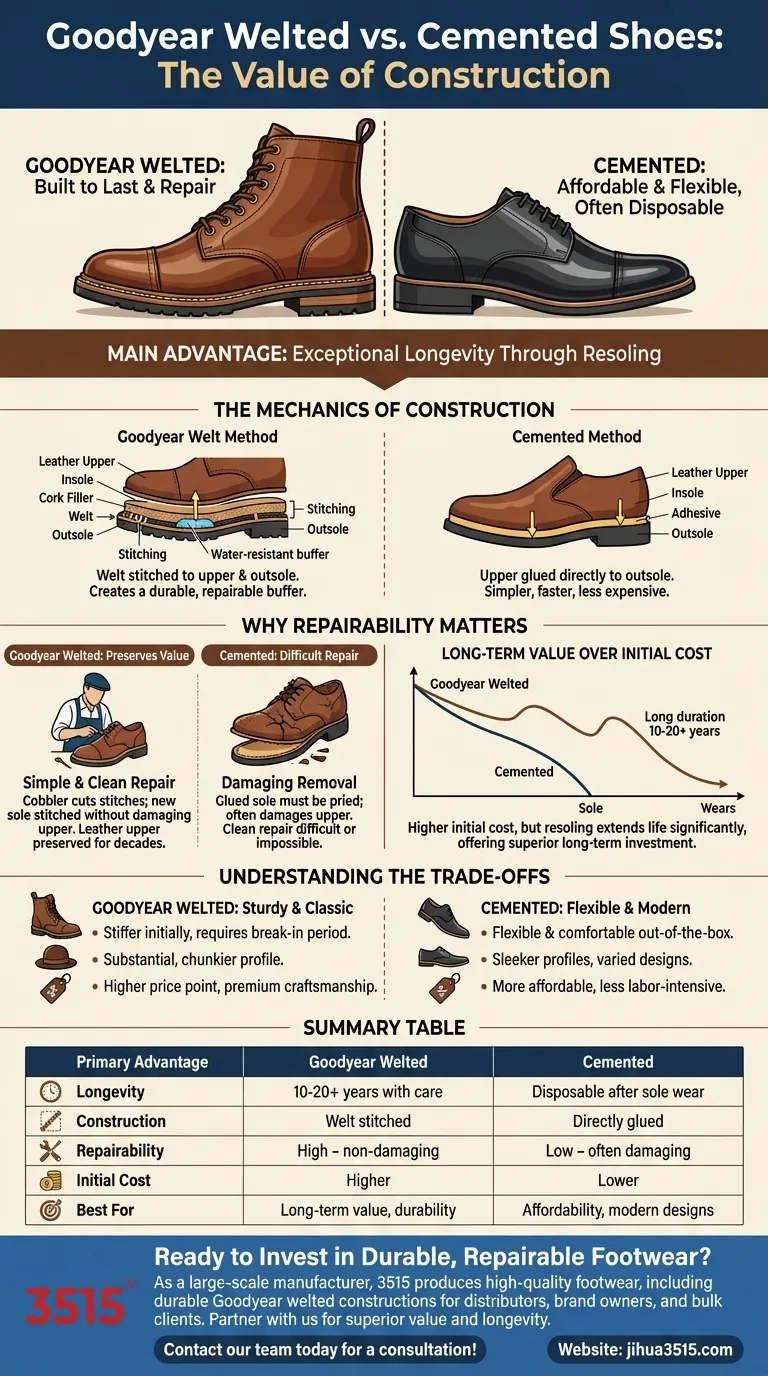
Related Products
- Durable Rubber-Soled Utility Shoes for Wholesale & Custom Brand Manufacturing
- Custom Manufactured Air Cushion Leather Business Shoes for Wholesale
- Wholesale Breathable Training Shoes Custom Athletic Footwear Manufacturer
- Wholesale Comfortable Business Casual Shoes Custom Manufacturing
- Wholesale Durable & Breathable Training Shoes for Custom Brands
People Also Ask
- What historical breakthrough in 1844 contributed to modern shoe sole manufacturing? The Vulcanization Revolution
- What are the benefits of rubber work shoes? Unbeatable Protection for Wet & Demanding Jobs
- Which type of sole is better for premium sneakers and why? The Definitive Guide to Rubber Outsoles
- What makes natural rubber provide excellent traction and grip? Unlocking Superior Performance with Molecular Science
- Why should we wear rubber soled shoes? Unlock Superior Safety and Durability












